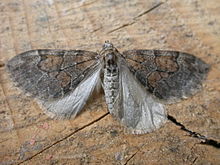KolbertBot (talk | contribs) m Bot: HTTP→HTTPS (v485) |
Lepidoptera~plwiki (talk | contribs) |
||
| Line 35: | Line 35: | ||
==External links== |
==External links== |
||
{{Commonscat|Thera obeliscata}} |
{{Commonscat|Thera obeliscata}} |
||
| ⚫ | |||
*[http://www.lepidoptera.eu/show.php?ID=505 European Butterflies and Moths] |
|||
*[http://www.faunaeur.org/full_results.php?id=444645 Fauna Europaea] |
*[http://www.faunaeur.org/full_results.php?id=444645 Fauna Europaea] |
||
*[https://lepidoptera.eu/species/505 Lepidoptera Mundi] by Christopher Jonko |
|||
*[http://www.lepiforum.de/lepiwiki.pl?Thera_Obeliscata Lepiforum.de] |
*[http://www.lepiforum.de/lepiwiki.pl?Thera_Obeliscata Lepiforum.de] |
||
| ⚫ | |||
*[http://www.vlindernet.nl/vlindersoort.php?vq=Thera+obeliscata&gezocht=1 Vlindernet.nl {{nl}}] |
*[http://www.vlindernet.nl/vlindersoort.php?vq=Thera+obeliscata&gezocht=1 Vlindernet.nl {{nl}}] |
||
Revision as of 12:41, 15 July 2018
| Grey pine carpet | |
|---|---|

| |

| |
| Scientific classification | |
| Kingdom: | |
| Phylum: | |
| Class: | |
| Order: | |
| Family: | |
| Genus: | |
| Species: | T. obeliscata
|
| Binomial name | |
| Thera obeliscata (Hübner, 1787)
| |
Thera obeliscata, the grey pine carpet, is a moth of the family Geometridae. It is found throughout north and central Europe and east across the Palearctic to Siberia, and south to the Caucasus and Transcaucasia. In the Alps it can be found at an altitude of over 1500 metres.
Description
The wingspan is 28–36 mm. Forewing reddish brown or fulvous, the distal edge of the median band not strongly indented, or with only one deep indentation (on the fold); pale subterminal line commonly obsolete, or if present, not strongly dentate. Hindwing rather more glossy and brownish than that of Thera variata , the discal dot generally altogether obsolete on the upperside, though expressed beneath. — ab. tristrigaria Donov. is an infrequent aberration with 3 unusually well developed, elongate interneural submarginal streaks between the 5th subcostal and 3rd radial veins. The aberration, ab. mediolucens Rossi, is a rather striking form in which the ground-colour is appreciably darkened while the median band remains fulvous, thus appearing lighter, or at least brighter, than the adjoining areas. — ab. obliterata B. White is almost unicolorous brown-black or black-brown in Britain and occasionally in the mountains of Central Italy.[1]
The larva primarily feeds on Pinus sylvestris and Picea abies. The species prefers settled pine forests.
References
- ^ Prout , L.B. 1912–16. Geometridae. In A. Seitz (ed.) The Macrolepidoptera of the World. The Palaearctic Geometridae, 4. 479 pp. Alfred Kernen, Stuttgart.
External links
- Fauna Europaea
- Lepidoptera Mundi by Christopher Jonko
- Lepiforum.de
- UK Moths
- Vlindernet.nl Template:Nl